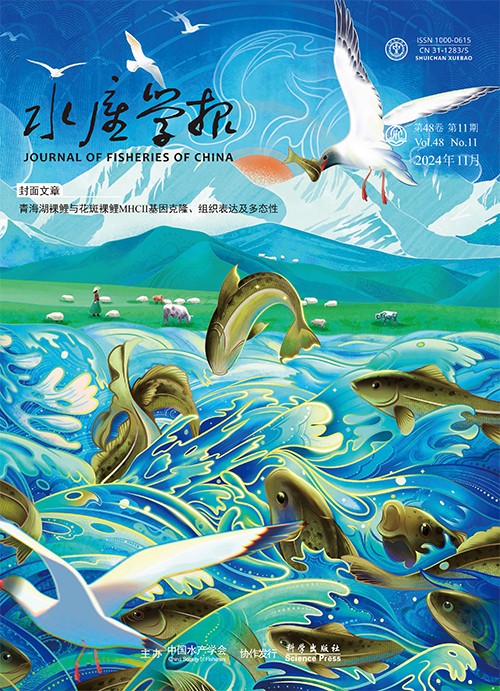Comparative analysis of genetic diversity of Dosidicus gigas from eastern Pacific Ocean based on molecular markers of mitochondrial DNA
Q4 Environmental Science
引用次数: 0
Abstract
The worldwide climate and marine environmental changes have significant impacts on the distributions and fishery resources abundance fluctuations of Dosidicus gigas in the East Pacific Ocean. It is important to investigate genetic variance and population genetic structure of D. gigas in order to exploit and manage this squid scientifically. In this study,the genetic diversity and the genetic differentiation betw een tw o geographical populations of D. gigas w ere analyzed based on tw o mitochondrial DNA molecular markers. The results show ed that the number of haplotype,haplotype diversities,nucleotide diversities and average nucleotide differences w ere 7,( 0. 397 ± 0. 079),( 0. 001 09 ± 0. 000 96) and 0. 600 respectively in all Cytb sequences of tw o geographical populations,and haplotype diversity in population off the coast of Peru w as only( 0. 282 ± 0. 101) w hich w as significantly low er than that of equatorial w aters. On the other hand,the number of haplotype,haplotype diversities,nucleotide diversities and average nucleotide differences in all COⅠ sequences w ere 17,( 0. 787 ± 0. 051),( 0. 002 90 ± 0. 001 38) and 1. 802 respectively. The pairw ise fixation index F st and median netw ork revealed lack of genetic structure betw een populations of equatorial w aters and off the coast of Peru( Cytb: F st= 0. 055 23,P 0. 05; CO Ⅰ: F st= 0. 005 91,P 0. 05),and this might be caused by equational oceanographic current. The minimum spanning netw ork tree,mismatch distribution analysis and neutrality tests suggested that D. gigas experienced a recent population expansion,possibly 138 900 to 167 900 years ago.基于线粒体DNA分子标记的东太平洋土sidicus gigas遗传多样性比较分析
全球气候和海洋环境变化对东太平洋大田螺的分布和渔业资源丰度波动有显著影响。研究巨乌贼的遗传变异和种群遗传结构,对科学开发和管理巨乌贼具有重要意义。本研究利用线粒体DNA分子标记分析了两个地理居群间的遗传多样性和遗传分化。结果表明,单倍型数量、单倍型多样性、核苷酸多样性和平均核苷酸差异分别为7、0。397±0。079),(0。001 09±0。000 96)和0。在2个地理种群的所有Cytb序列中,单倍型多样性分别为600个,秘鲁沿海种群的单倍型多样性仅为(0。282±0。101) w显著低于赤道w水域。另一方面,所有COⅠ序列的单倍型数量、单倍型多样性、核苷酸多样性和平均核苷酸差异w分别为17,(0。787±0。051),(0。002 90±0。001 38)和1。分别为802。配对固定指数F - 1和中位网络显示赤道w水域和秘鲁海岸种群之间缺乏遗传结构(Cytb: F - 1 = 0)。055 23, p 0。05;COⅠ:F st= 0。[05] 91, p . 0。05),这可能是由相等的海洋洋流引起的。最小跨越网络树、错配分布分析和中性测试表明,巨齿龙经历了最近的种群扩张,可能在13.89万年至16.79万年之间。
本文章由计算机程序翻译,如有差异,请以英文原文为准。
求助全文
约1分钟内获得全文
求助全文
来源期刊

水产学报
Environmental Science-Management, Monitoring, Policy and Law
CiteScore
1.40
自引率
0.00%
发文量
5213
期刊介绍:
"Fisheries of" mainly reflects the results of scientific research and development of the direction of aquaculture for domestic and foreign academic exchanges Fisheries Service. Mainly basic research published in Fisheries, aquaculture and proliferation of fishing waters environmental protection, preservation of aquatic products processing and utilization, fishing equipment, and other aspects of mechanical papers, research briefings and reviewed.
 求助内容:
求助内容: 应助结果提醒方式:
应助结果提醒方式:


